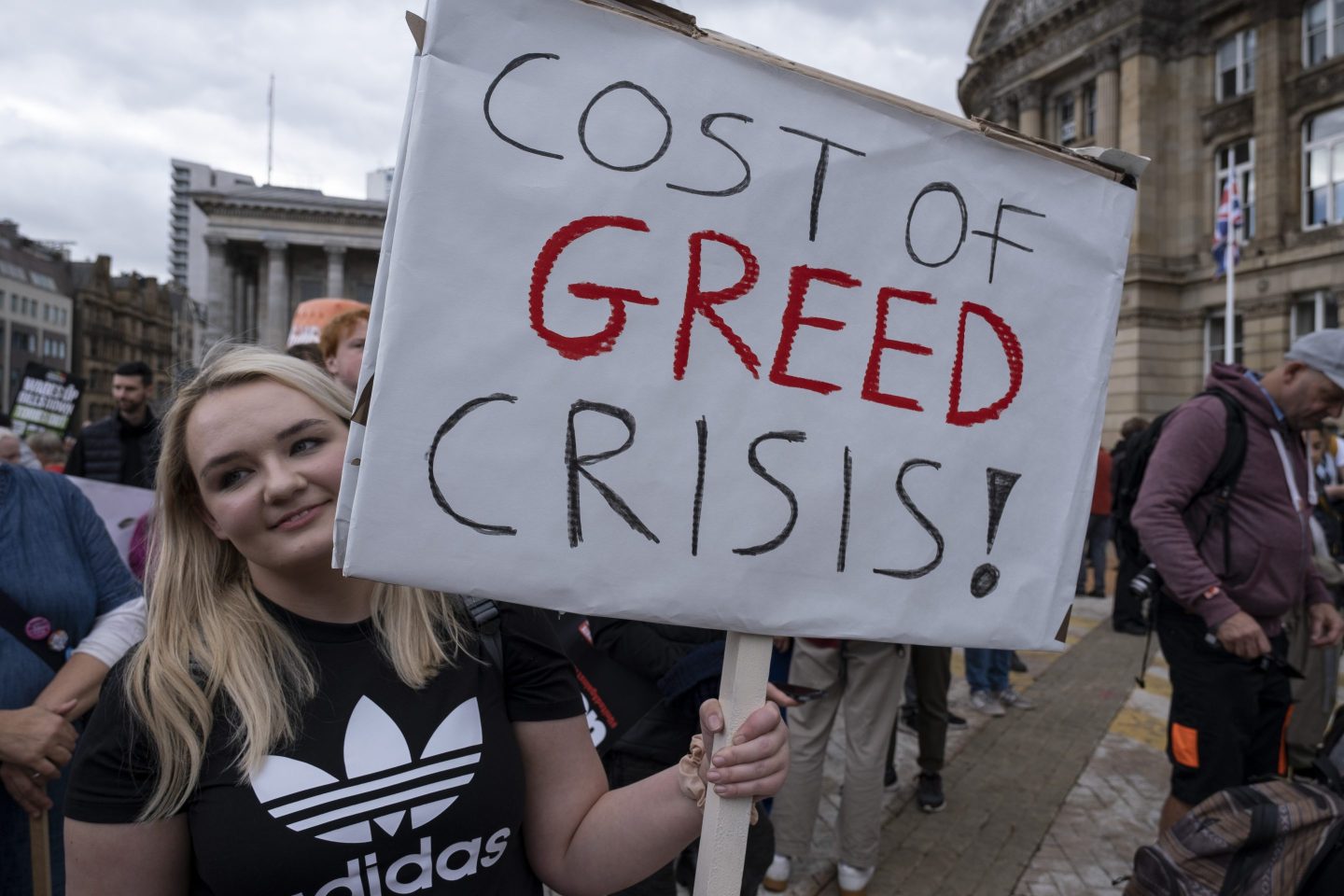
当成本上涨的时候,利润是否也会增长?这并不是资本主义的运行方式,但却是最近的趋势。一年多来,美国以及全世界的消费者和企业都备受恶性通胀的折磨。但成本暴涨并没有阻止企业赚取创纪录的利润。去年,《财富》500强公司营收16.1万亿美元,利润达到创纪录的1.8万亿美元。以左翼为主的政治人物针对这种现象发出了警告,例如伯尼·桑德斯在国会的讲话,或者乔恩·斯图尔特最近对美国前财长拉里·萨默斯的质问。但现在,一位来自全球历史最悠久、规模最大的投资银行之一的经济学家也发出了同样的警告。
阿尔伯特·爱德华兹在有159年历史的法国兴业银行(Société Générale)担任全球策略师。他最近发表了一篇言辞激烈的报告,分析了所谓“贪婪性通胀”这种现象。他表示,企业,尤其是在美国、英国等发达经济体,利用疫情期间原材料成本上涨和俄乌冲突作为“借口”,趁机涨价,将利润率提高到新的水平。这家法国投资银行不仅历史悠久,它还是金融稳定性委员会(Financial Stability Board)选定的“系统重要性”银行之一。金融稳定性委员会是二十国集团的跨国组织,致力于保障全球金融系统的安全。
此外,爱德华兹在周二版的《每周全球策略》(Global Strategy Weekly)中写道,当前企业贪婪性通胀的水平,是他在金融领域从业四十年来“前所未见的”和“令人震惊的”。堪萨斯城联邦储备银行(Federal Reserve Bank of Kansas City)1月份的一项研究发现,与整个经济历史相比,在2021年,企业价格与生产成品的比率上涨,即“加成增长”,变成了推动通胀上涨的一个更加重要的因素。
通常情况下,尤其是经济增长放缓时,产品价格和劳动力成本上涨会挤压企业的利润率。但爱德华兹认为,经济分析局(Bureau of Economic Analysis,BEA)上周发布的数据显示,在第四季度,企业利润率与成本的比率依旧接近历史最高水平。这位策略师表示,他曾假设随着经济增长放缓,在去年年底,利润率应该“大幅下降”,但事实相反,“我大错特错!”
爱德华兹还表示,他担心如果消费者持续受到通货膨胀的折磨,美国和其他国家的企业“超高的利润率”可能最终“引发社会动荡”。
他警告称:“贪婪性通胀必须结束。否则,我们可能会看到资本主义的末日。这是政策制定者无法再忽视的一个严重问题。”
爱德华兹的报告意义重大,它让一种迄今为止一直代表进步派立场的观点进入主流视野。例如,上个月,前《每日秀》(Daily Show)主持人乔恩·斯图尔特在Apple TV的新节目《The Problem》中采访了拉里·萨默斯,就贪婪性通胀问题进行了辩论。两人在争论美联储为应对通胀、通过加息压低工资的做法是否正确时,斯图尔特提出:“我们为什么不想方设法降低企业的利润?因为据估计,企业利润要为30%或者40%的通胀负责?”
萨默斯立即回答称,他并不认为“企业突然变得贪婪这种观点站得住脚。”爱德华兹却似乎认为,这种观点有理有据。
是时候实行物价管制了?
爱德华兹提出了解决贪婪性通胀上涨的一个有争议的解决方案。他表示,这个解决方案表明他对资本主义体制的“信心减弱”。爱德华兹表示,对于这类问题有一个工具,那就是上世纪70年代的物价管制,这对于“经历过当时物价和收入政策失败的人们来说”或许是不可思议的转变。
物价管制,即由政府规定允许企业向消费者收取的价格,曾经备受指责,从公元前1595年第一个巴比伦帝国的灭亡,到上世纪70年代尼克松和卡特政府时期加油站排起的长队,都被归咎于物价管制。有一个最常见的例子被用于证明物价管制极其愚蠢,那就是罗马帝国皇帝戴克里先。公元301年,为了应对失控的通货膨胀,他颁布了劳动力、商品的“最高物价法令”。该法令规定违者将被处死,最终却起到了负面作用,引发了商品短缺,依赖政府小麦,最终导致该法令被废除。
爱德华兹表示,因为这段历史,他的许多同事“不太赞同执行物价管制”,但他认为物价管制可能是合理的手段,因为“有些情况似乎已经脱离了资本主义的范畴。”
这位策略师引用了马萨诸塞大学阿默斯特分校(University of Massachusetts Amherst)经济学家伊莎贝拉·韦伯和伊凡·瓦斯纳的论文《卖方的通胀、利润与冲突:为什么大企业突然涨价?》(Sellers’ Inflation, Profits and Conflict: Why Can Large Firms Hike Prices in an Emergency?)。这篇论文发现,企业在疫情期间“哄抬物价”,并认为临时物价管制是防止哄抬物价导致的“螺旋式通胀”的唯一方法。
爱德华兹认为:“结合他们对于如何应对贪婪性通胀的结论,物价管制似乎是一种最受欢迎的控制通胀的方法。”(财富中文网)
翻译:刘进龙
审校:汪皓
当成本上涨的时候,利润是否也会增长?这并不是资本主义的运行方式,但却是最近的趋势。一年多来,美国以及全世界的消费者和企业都备受恶性通胀的折磨。但成本暴涨并没有阻止企业赚取创纪录的利润。去年,《财富》500强公司营收16.1万亿美元,利润达到创纪录的1.8万亿美元。以左翼为主的政治人物针对这种现象发出了警告,例如伯尼·桑德斯在国会的讲话,或者乔恩·斯图尔特最近对美国前财长拉里·萨默斯的质问。但现在,一位来自全球历史最悠久、规模最大的投资银行之一的经济学家也发出了同样的警告。
阿尔伯特·爱德华兹在有159年历史的法国兴业银行(Société Générale)担任全球策略师。他最近发表了一篇言辞激烈的报告,分析了所谓“贪婪性通胀”这种现象。他表示,企业,尤其是在美国、英国等发达经济体,利用疫情期间原材料成本上涨和俄乌冲突作为“借口”,趁机涨价,将利润率提高到新的水平。这家法国投资银行不仅历史悠久,它还是金融稳定性委员会(Financial Stability Board)选定的“系统重要性”银行之一。金融稳定性委员会是二十国集团的跨国组织,致力于保障全球金融系统的安全。
此外,爱德华兹在周二版的《每周全球策略》(Global Strategy Weekly)中写道,当前企业贪婪性通胀的水平,是他在金融领域从业四十年来“前所未见的”和“令人震惊的”。堪萨斯城联邦储备银行(Federal Reserve Bank of Kansas City)1月份的一项研究发现,与整个经济历史相比,在2021年,企业价格与生产成品的比率上涨,即“加成增长”,变成了推动通胀上涨的一个更加重要的因素。
通常情况下,尤其是经济增长放缓时,产品价格和劳动力成本上涨会挤压企业的利润率。但爱德华兹认为,经济分析局(Bureau of Economic Analysis,BEA)上周发布的数据显示,在第四季度,企业利润率与成本的比率依旧接近历史最高水平。这位策略师表示,他曾假设随着经济增长放缓,在去年年底,利润率应该“大幅下降”,但事实相反,“我大错特错!”
爱德华兹还表示,他担心如果消费者持续受到通货膨胀的折磨,美国和其他国家的企业“超高的利润率”可能最终“引发社会动荡”。
他警告称:“贪婪性通胀必须结束。否则,我们可能会看到资本主义的末日。这是政策制定者无法再忽视的一个严重问题。”
爱德华兹的报告意义重大,它让一种迄今为止一直代表进步派立场的观点进入主流视野。例如,上个月,前《每日秀》(Daily Show)主持人乔恩·斯图尔特在Apple TV的新节目《The Problem》中采访了拉里·萨默斯,就贪婪性通胀问题进行了辩论。两人在争论美联储为应对通胀、通过加息压低工资的做法是否正确时,斯图尔特提出:“我们为什么不想方设法降低企业的利润?因为据估计,企业利润要为30%或者40%的通胀负责?”
萨默斯立即回答称,他并不认为“企业突然变得贪婪这种观点站得住脚。”爱德华兹却似乎认为,这种观点有理有据。
是时候实行物价管制了?
爱德华兹提出了解决贪婪性通胀上涨的一个有争议的解决方案。他表示,这个解决方案表明他对资本主义体制的“信心减弱”。爱德华兹表示,对于这类问题有一个工具,那就是上世纪70年代的物价管制,这对于“经历过当时物价和收入政策失败的人们来说”或许是不可思议的转变。
物价管制,即由政府规定允许企业向消费者收取的价格,曾经备受指责,从公元前1595年第一个巴比伦帝国的灭亡,到上世纪70年代尼克松和卡特政府时期加油站排起的长队,都被归咎于物价管制。有一个最常见的例子被用于证明物价管制极其愚蠢,那就是罗马帝国皇帝戴克里先。公元301年,为了应对失控的通货膨胀,他颁布了劳动力、商品的“最高物价法令”。该法令规定违者将被处死,最终却起到了负面作用,引发了商品短缺,依赖政府小麦,最终导致该法令被废除。
爱德华兹表示,因为这段历史,他的许多同事“不太赞同执行物价管制”,但他认为物价管制可能是合理的手段,因为“有些情况似乎已经脱离了资本主义的范畴。”
这位策略师引用了马萨诸塞大学阿默斯特分校(University of Massachusetts Amherst)经济学家伊莎贝拉·韦伯和伊凡·瓦斯纳的论文《卖方的通胀、利润与冲突:为什么大企业突然涨价?》(Sellers’ Inflation, Profits and Conflict: Why Can Large Firms Hike Prices in an Emergency?)。这篇论文发现,企业在疫情期间“哄抬物价”,并认为临时物价管制是防止哄抬物价导致的“螺旋式通胀”的唯一方法。
爱德华兹认为:“结合他们对于如何应对贪婪性通胀的结论,物价管制似乎是一种最受欢迎的控制通胀的方法。”(财富中文网)
翻译:刘进龙
审校:汪皓
When costs go up, so do profits? That’s not how capitalism is supposed to work, but that is the recent trend. For over a year now, consumers and businesses, both in the U.S. and worldwide, have struggled with stubborn inflation. But the soaring costs haven’t prevented corporations from raking in record profits. The companies in last year’s Fortune 500 alone generated an all-time high $1.8 trillion in profit on $16.1 trillion in revenue. Voices largely on the left side of the political spectrum have been sounding the alarm on this—think: Bernie Sanders in Congress or Jon Stewart’s recent grilling of former Treasury Secretary Larry Summers—but now an economist at one of the world’s oldest and greatest investment banks is singing the same tune.
Albert Edwards, a global strategist at the 159-year-old bank Société Générale, just released a blistering note on the phenomenon that has come to be called Greedflation. Corporations, particularly in developed economies like the U.S. and U.K., have used rising raw material costs amid the pandemic and the war in Ukraine as an “excuse” to raise prices and expand profit margins to new heights, he said. And the French investment bank isn’t just historic: It’s one of the select banks considered to be “systemically important” by the Financial Stability Board, the G20’s international body dedicated to safeguarding the global financial system.
Furthermore, Edwards wrote, in the Tuesday edition of his Global Strategy Weekly, after four decades of working in finance, he’s never seen anything like the “unprecedented” and “astonishing” levels of corporate Greedflation in this economic cycle. To his point, a January study from the Federal Reserve Bank of Kansas City found that “markup growth”—the increase in the ratio between the price a firm charges and its cost of production—was a far more important factor driving inflation in 2021 than it has been throughout economic history.
Typically, higher commodity prices and labor costs squeeze corporate margins, especially if the economy is slowing. But Edwards pointed to data released by the Bureau of Economic Analysis (BEA) last week that showed profit margins still near a record high relative to costs in the fourth quarter. The strategist said he assumed margins would have “declined sharply” at the end of last year as the economy slowed, but instead, “How wrong I was!”
Edwards added that he fears the “super-normal profit margins” of corporations in the U.S. and abroad could eventually “inflame social unrest” if consumers continue to struggle with inflation.
“The end of Greedflation must surely come. Otherwise, we may be looking at the end of capitalism,” he warned. “This is a big issue for policymakers that simply cannot be ignored any longer.”
Edwards’s note could be significant in bringing a viewpoint that has thus far lived on the progressive fringe into the mainstream. For instance, a debate over Greedflation broke out last month, during former Daily Show host Jon Stewart’s interview with Larry Summers on his new Apple TV show, The Problem. As Stewart and Summers debated whether the Fed was right to pressure wages to fall by raising interest rates in its inflation fight, Stewart pivoted: “Why aren’t we attacking corporate profit in any way? Because that’s been estimated to be 30% of inflation, 40% of inflation?”
Summers was quick to respond that he didn’t think it was “a tenable view that all of a sudden corporations became greedy.” Edwards seems to be saying that it actually is quite tenable.
Time to control prices?
Edwards proposed a controversial solution to fix the rise of Greedflation, which he said reflects his “weakening confidence” in the capitalist system itself. In a once unthinkable twist to “those of us who lived through the failed prices and incomes policies of the 1970s,” Edwards said there is a tool for this kind of problem, and it’s from that same decade: price controls.
Price controls—or when a government mandates the prices businesses are allowed to charge consumers—have been blamed for everything from the fall of the first Babylonian Empire in 1595 BC to the long lines at the gas pump of the Nixon and Carter administrations in the ’70s. One of the most common stories about the supposed folly of price controls comes from the Roman emperor Diocletian, who enacted an “edict on maximum prices” for labor, commodities, and more to combat rampant inflation in AD 301. But the edict, which included a death penalty for anyone who broke it, eventually backfired, creating a scarcity of goods and reliance on government wheat that led to its repeal.
Edwards noted that many of his colleagues are “less sympathetic to the use of price controls” because of this history, but he argues their use may be warranted because “something seems to have broken with capitalism.”
The strategist referenced a paper by University of Massachusetts Amherst economists Isabella Weber and Evan Wasner, titled, “Sellers’ Inflation, Profits and Conflict: Why Can Large Firms Hike Prices in an Emergency?” which found that corporations engaged in “price gouging” during the pandemic and argued temporary price controls may be the only way to prevent the “inflationary spirals” that could come as a result of this gouging.
“Looking at their conclusions on how to deal with Greedflation, price controls seem to emerge as a favorite method of control,” Edwards argued.






